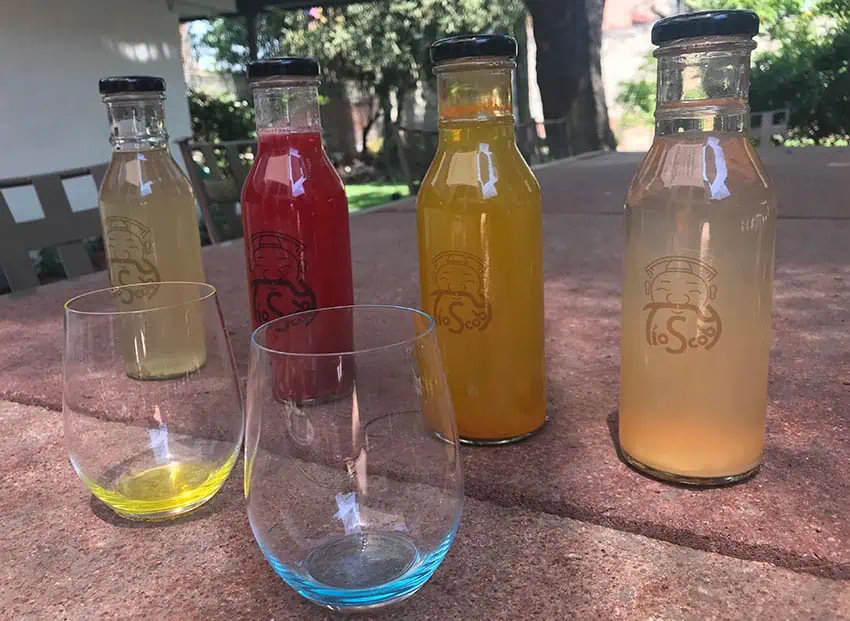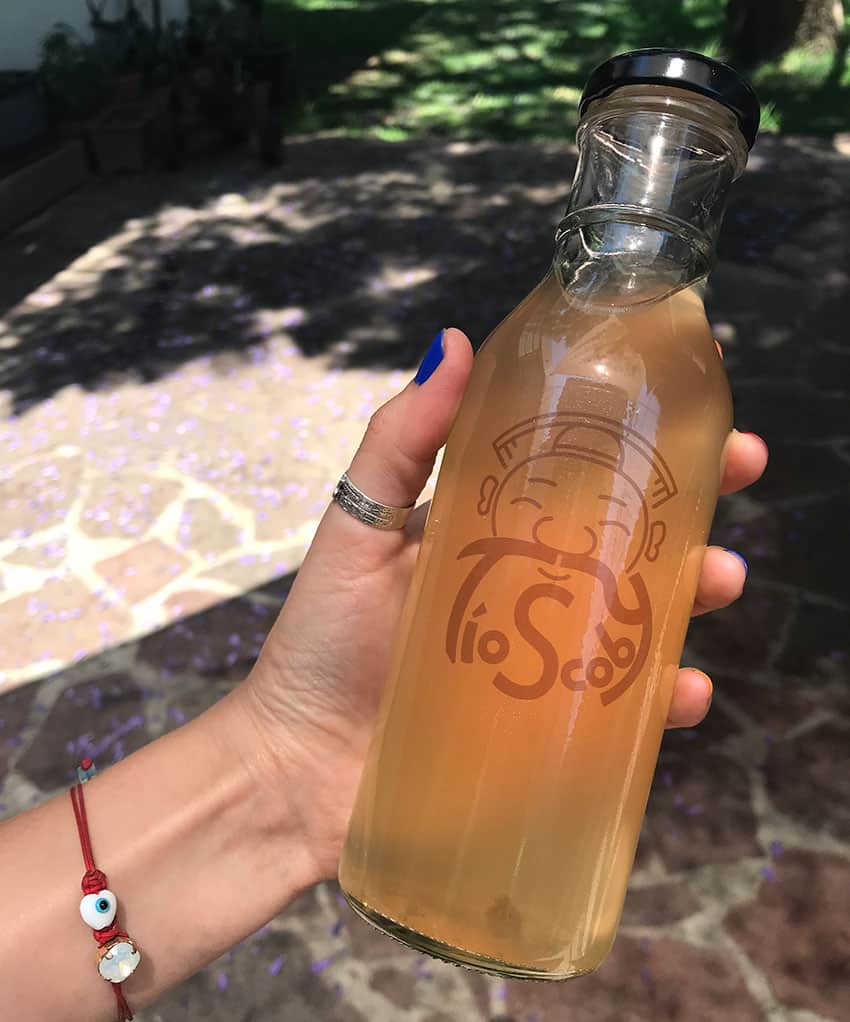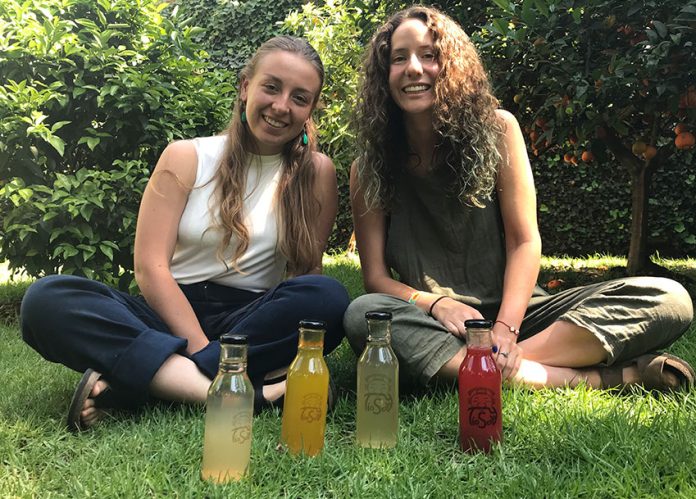Tío Scoby is a small business. As in, really small. Run by two women out of a home near the National Autonomous University in Mexico City, it produces 50 liters per week of kombucha, a fermented beverage touted for its many health benefits.
But keeping it small is part of their goal, say owners Lucía Pesqueira Mateos and Mariana Diaz. Small size helps maintain quality control.
“We want to make this for our community for people to have healthier options,” said Diaz, who studies architecture at the Universidad Iberoamericana.
Specifically, in the case of Mexico, Diaz said, options healthier than soda are needed.
“I never really liked drinking soda, but I do like the fizziness,” Diaz said. “Sometimes I want to have something fizzy, but also something cold, light and refreshing and with unique flavors from different vegetables and fruits.”

Kombucha, Diaz said, fulfills all those needs. And Tío Scoby’s products offer her favorite qualities of the beverage.
Kombucha is one of many fermented beverages beloved the world over. Although the exact origins are not known, it is thought to have originated in Manchuria where the drink is traditionally consumed. Made with natural sugars, green or black tea and often a fruit or vegetable for flavor, it has a light alcohol content of about 0.5%.
The drink has become a fad in the past decade or so in the United States and elsewhere. And the fad is starting to kick in in Mexico as well. Some small cafes and large supermarkets carry Mexican kombuchas.
After sampling the beverage on a trip to Costa Rica, Diaz didn’t like many of the kombuchas she tried at various stores upon her return to Mexico. So she decided to make her own.
“Kombucha is similar to beer in that it has yeast,” said Pesqueira, a microbiologist. “SCOBY is an acronym for Symbiotic Culture Of Bacteria and Yeast, which is present in all kombuchas.”
The yeast transforms the sugars into ethanol and CO2 resulting in the slight alcohol concentration. The fizziness results from the CO2. The yeast also has bacteria that take ethanol and convert it into organic acids that are very good for your digestive system.
It has sugar, but the sugar has been transformed. So when you drink a kombucha, you’re drinking vitamins and beneficial bacteria. The body’s highest concentration of bacteria is the gut, and these microorganisms feed the good bacteria.
Because it’s a bit sour, kombucha hasn’t totally caught on in Mexico. But it’s not a stretch to see why Tío Scoby’s products are in demand. While not accustomed to kombucha itself, many Mexicans are familiar with other fermented, ancestral drinks such as pulque (fermented agave nectar), tejuino (fermented corn), tepache (fermented pineapple and sugar) and various fermented cacao beverages.
“Pulque is another probiotic beverage and it’s alive. All these probiotic beverages are alive. That’s what makes them unique. Pulque and kombucha are living beverages,” said Pesqueira, who recommends drinking a third of a 360ml bottle of Tío Scoby daily for healthy digestion.
“In Mexico we are not as familiar with fermented foods or beverages compared to Asia, for example. In Europe, you have a lot of fermented fruits and beverages, pickles, sauerkraut. We’ve been making fermented foods here for centuries as a way to preserve food. It’s interesting how we have lost this really important resource. Everything now is pasteurized and, when you do that, you lose a lot of beneficial properties.”
The SCOBY itself is a living organism from which all kombucha is made. It can be split off from a mother SCOBY and can also regenerate from smaller pieces. The SCOBY Tío Scoby uses was given to Diaz by a woman in Guatemala.
“Yeast is a type of fungus, but on a microscopic level,” Pesqueira said. “Kombucha has so many types of bacteria and yeast . . . and the most common would be like what you find in beer. There are different types of SCOBY in Asia and in the U.S. . . . Sometimes one is fizzier than the other. It’s hard to determine how much of a specific microorganism exists in each SCOBY.”

Fermentation of a batch of kombucha takes about seven to 10 days in Mexico City, depending on the season. Because it’s a natural process, it is affected by the elements. Fermentation takes longer in colder regions, which is why Diaz and Pesqueira recommend refrigerating each bottle of Tío Scoby and consuming it within a month.
“Refrigeration slows down fermentation, but the fermentation actually never stops,” Diaz said.
On a sunny Sunday afternoon on the city’s southside, Pesqueira and Diaz reflected on what it’s taken to start Tío Scoby and where they’d like to see it go. The women prepare kombucha with rotating flavors, always loving to experiment, though they almost always have a berry, orange, ginger or unflavored version in stock.
“We just started to read about it and then we started to do it,” Diaz said. “We are still reading up on it, seeing what we’d like to add, learning more things all the time. We’ve had a request to make it fizzier, so we might make one option with more fizz. We’ve also been thinking about starting to make kefir — a fermented milk drink popular in Eastern Europe and Russia.”
Recently, Diaz and Pesqueira teamed up with local bartenders to make a “mezkombucha” using kombucha as a mixer for mezcal. While admittedly the high alcohol content of mezcal kills some of the good bacteria in kombucha, Pesqueira said it’s a healthier alternative than mixing with soda or juice that has added sugar. It can also help counter the effects of a hangover, Diaz said.
These businesswomen are obviously trying to bring kombucha onto the Mexican scene in unique ways.
“Our next step is to sell from coffee shops and yoga centers. Now we do deliveries each week,” Pesqueira said. “We’re not looking to have our own storefront. We sell at bazaars, but they are quite expensive. Some ask 2,000 pesos for two days and our kombucha is only 50 pesos per bottle, so we would have to sell a lot of kombucha to get a return. But it’s also good for us to get the name out there and to meet people and share what kombucha is.”
Additionally, Diaz and Pesqueira have begun giving classes on the health benefits of kombucha as well as teaching how to make it.
“Often Tío Scoby has been the first experience that someone has had with kombucha,” Diaz said. “We get asked so many questions and we love to explain. We send voice messages, articles we’ve read or things we’ve written. I love that people are taking an interest in their health. It speaks about a new curiosity in people in Mexico. There are certainly those who don’t want to try it because it’s different. The fact that it’s something different can be an obstacle, but also an opportunity.”
• To place an order with Tío Scoby, message Diaz and Pesqueira on Instagram.
Megan Frye is a writer, photographer and translator living in Mexico City. Her experience includes newsroom journalism and non-profit administration. She has been published in several international publications.
